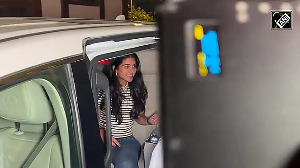 Ramesh Thapar, who recently drove from Mumbai to Goa, took 16 hours to reach his destination. Thapar wanted to stretch and move his legs at times, but could not do so since he had to keep his foot on the pedal to keep the car in motion.
Ramesh Thapar, who recently drove from Mumbai to Goa, took 16 hours to reach his destination. Thapar wanted to stretch and move his legs at times, but could not do so since he had to keep his foot on the pedal to keep the car in motion.
However, if he was the owner of an eighth-generation Honda Civic, the scenario would be different. The Honda Civic's automatic version comes equipped with cruise control which, when activated, drives the car by itself. The company's spokesperson says this facility is ideal on highways and for speeds above 40 km per hour.
If you still believe that cars run on just batteries, distributors or alternators, and carburettors, think again. "The way to achieve comfort and safety in premium cars is through software and electronics. In future car majors will rely more on software and electronics to differentiate their premium brands," says Kumar Kandaswami, senior director of Deloitte Touche Tohmatsu India.
Today's premium cars embed at least 100 million lines of software codes that control around 2,000 functions in the car. Software and electronics comprise 30-35 per cent of the total cost of a premium car, and the figure is expected to rise up to 50 per cent over the next five-10 years, says Kandaswami.
Software is used in airbags, alarms, cruise controls, electronic-seat controls, power steering, anti-lock brakers, climate control, dashboard instrumentation, collision-avoidance system, and navigation and windshield wiper controls.
Cars, in fact, are imitating aircraft. For instance, Boeing's new 787 Dreamliner, scheduled to be delivered in 2010, requires about 6.5 million lines of software code to operate its avionics and onboard support systems.
Consider this. Premium-class automobiles like the Mercedes-Benz, Honda Civic or even the humble electric car Reva probably contain close to 100 million lines of software code. And all that software executes on 70 to 100 microprocessor-based electronic control units networked throughout the car's body.
The radio and navigation system alone in the S-class Mercedes-Benz requires over 20 million lines of code and contains nearly as many ECUs as the new Airbus A380 (excluding the plane's in-flight entertainment system).
And the software in cars is only going to grow in both amount and complexity. Frost & Sullivan recently estimated that cars will require 200-300 million lines of software code in the near future. Even low-end cars now have 30-50 ECUs embedded in the body, doors, dash, roof, trunk, seats, and just about anywhere else the car's designers can think to put them.
Take this case in point. While airbags are useful in saving lives, their malfunction, either inflating too early or too less, could prove fatal. Hence, the latest Honda Accord incorporates an intelligent six airbag system controlled by a software that decides how much inflation is required to cushion the driver and passengers. On collision the process takes milliseconds .
German premium car manufacturer Mercedes-Benz, on its part, incorporates a new technology called Attention Assist (AA) in its S-Class models launched in the domestic market this year. Wilfried Aulbur, managing director and CEO of Mercedes-Benz, says the system has been developed to help reduce driver fatigue and reduce accidents.
"AA is a software that minutely monitors and records the motoring behaviour of a driver from the steering wheel movement, frequency of lane changes etc. Once there is a deviation from these patterns, which happens when the driver is drowsy or inebriated, AA sets off an alarm in the car thereby warning the driver and the occupants."
Apart from providing safety to passengers in the vehicle, premium car manufacturers like Mercedes-Benz also provide features that protect pedestrians. Once the car's electronics has identified, say a bicyclist in a street corner, the car's acceleration automatically slows down even if the driver has failed to notice.
"Mercedes-Benz develops these technologies from a deep understanding of consumer behaviour, regulatory trends in the different countries we operate in, and from our vision of the future of mobility," says Aulbur.
Even the Reva incorporates a mini-computer that regulates energy distribution and generation. "Every time a driver brakes or accelerates during a traffic jam the battery in the car is charged thereby creating energy.
"All these are controlled by the onboard computer mounted in our cars. The computer also helps in diagnosing internal malfunctions," says Chetan Maini, chief technology officer and deputy chairman of Reva Electric Car Company.











 © 2025
© 2025